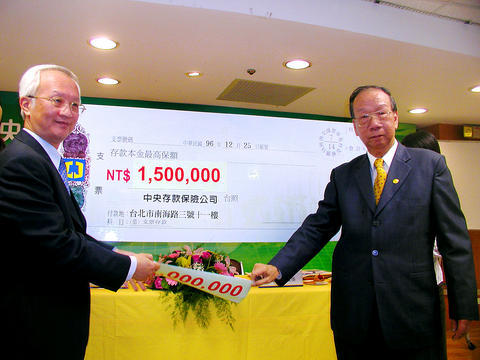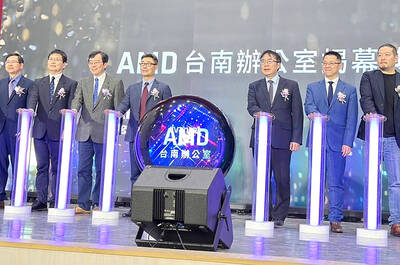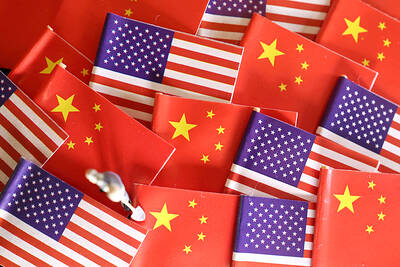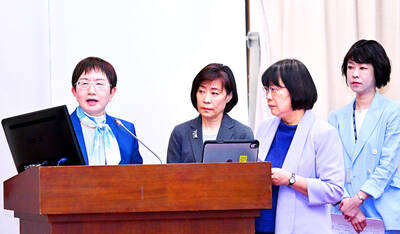The state-run Central Deposit Insurance Corp (CDIC, 中央存保) aims to offer insurance coverage to banks that are performing well at no cost after the CDIC's funds reach NT$200 billion (US$6.15 billion).
This proposal is aimed at addressing what some call an unfair situation in which there is not much difference between the premiums paid by troubled banks and those that perform well, a CDIC official said yesterday.
"Large-sized financial institutions are currently paying between NT$100 million and NT$200 million in insurance premiums to the CDIC each year," Johnson Chen (

PHOTO: LAN CHUN-TA, TAIPEI TIMES
"These institutions would be able to save their money if they reached the CDIC's standards, such as having a capital adequacy ratio higher than 10 percent, a non-performing loan ratio lower than 5 percent and profitability that meets the market average," he said.
After taking over five debt- ridden banks this year -- the Enterprise Bank of Hualien (
Chen said that because of the insufficient funds available for financial restructuring, the CDIC was covering 80 percent of the payments to buyers taking over debt-ridden banks, while the government's financial restructuring fund was paying the remaining 20 percent.
The government financial re-structuring fund is expected to come to an end in 2010 after it resolves the takeover of the nation's seven ailing banks, he said.
"Approximately NT$4.4 billion of the CDIC's funds comes from the insured institutions' annual premiums," Chen said.
"Two percent of the business tax for financial services will be injected into the CDIC's funds beginning in 2011 and is estimated to come to about NT$17 billion each year, accumulating NT$21.4 billion annually," Chen said. He estimates that starting from 2011, it would take the CDIC 10 years to reach its goal of NT$200 billion in 2021.
Beginning July 1, the nation's depositors will be able to receive NT$1.5 million maximum in insurance coverage per insured institution under the amended Deposit Insurance Act (

TECH CLUSTER: The US company’s new office is in the Shalun Smart Green Energy Science City, a new AI industry base and cybersecurity hub in southern Taiwan US chip designer Advanced Micro Devices Inc (AMD) yesterday launched an office in Tainan’s Gueiren District (歸仁), marking a significant milestone in the development of southern Taiwan’s artificial intelligence (AI) industry, the Tainan City Government said in a statement. AMD Taiwan general manager Vincent Chern (陳民皓) presided over the opening ceremony for the company’s new office at the Shalun Smart Green Energy Science City (沙崙智慧綠能科學城), a new AI industry base and cybersecurity hub in southern Taiwan. Facilities in the new office include an information processing center, and a research and development (R&D) center, the Tainan Economic Development Bureau said. The Ministry

ADVERSARIES: The new list includes 11 entities in China and one in Taiwan, which is a local branch of Chinese cloud computing firm Inspur Group The US added dozens of entities to a trade blacklist on Tuesday, the US Department of Commerce said, in part to disrupt Beijing’s artificial intelligence (AI) and advanced computing capabilities. The action affects 80 entities from countries including China, the United Arab Emirates and Iran, with the commerce department citing their “activities contrary to US national security and foreign policy.” Those added to the “entity list” are restricted from obtaining US items and technologies without government authorization. “We will not allow adversaries to exploit American technology to bolster their own militaries and threaten American lives,” US Secretary of Commerce Howard Lutnick said. The entities

Minister of Finance Chuang Tsui-yun (莊翠雲) yesterday told lawmakers that she “would not speculate,” but a “response plan” has been prepared in case Taiwan is targeted by US President Donald Trump’s reciprocal tariffs, which are to be announced on Wednesday next week. The Trump administration, including US Secretary of the Treasury Scott Bessent, has said that much of the proposed reciprocal tariffs would focus on the 15 countries that have the highest trade surpluses with the US. Bessent has referred to those countries as the “dirty 15,” but has not named them. Last year, Taiwan’s US$73.9 billion trade surplus with the US

The Taipei International Cycle Show (Taipei Cycle) yesterday opened at the Taipei Nangang Exhibition Center, with the event’s organizer expecting a steady recovery in the industry this year following a tough last year. This year, 980 companies from 35 countries are participating in the annual bicycle trade show, showcasing technological breakthroughs and market development trends of the bicycle industry at 3,600 booths, the Taiwan External Trade Development Council (TAITRA, 外貿協會) said in a statement. Under the theme “Ride the Revolution,” the exhibition has attracted more than 3,500 international buyers from 80 countries to preregister for the four-day event, which is expected to